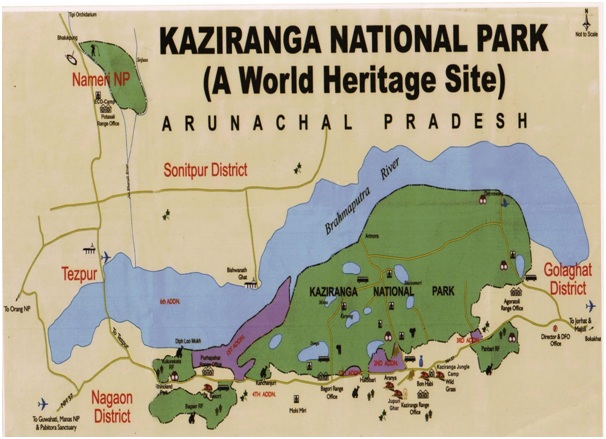

Context
Kaziranga National Park in Assam, home to the largest-population of the one-horned rhinoceros in the world, is releasing more carbon than it is absorbing.
About
Important facts about Kaziranga National Park
- Location: Spread over Golaghat and Nagaon districts of Assam Kaziranga National Park lies at the edge of eastern Himalayas.
- Origin: The park owes its existence to the conservation efforts of Mary Curzon and her husband Lord Curzon, then Viceroy of India.
- It became a reserve forest in 1904 primarily to protect the declining population of Rhinos.
- Assam National Park Act was passed by the Assam Government in 1968, declaring Kaziranga a designated national park with an area of 430 sq km.
- An additional area of 429 sq km was added later to provide an extended habitat to the wild animals.
- Central Government recognized it as a national park in 1974.
- Kaziranga National Park got the status of a tiger reserve in 2006
- Kaziranga National Park is a UNESCO World Heritage Site.
- The Kaziranga National Park in Assam is home to the threatened one-horned Rhino.
- Other important species: Wild Asiatic Water Buffalo and Eastern Swamp Deer, leopards, Royal Bengal Tigers, two of the largest snakes in the world (the Reticulated Python and Rock Python), King Cobra (the longest venomous snake in the world)

|
The name game Kaziranga is also locally known as the land of red Goats (Deer). This is because, it derives its name from the words Kazi and Ranga. Kazi in Karbi language (one of the local dialects of Assam) means ‘Goat’. And Ranga means ‘Red’. |
Why Kaziranga National Park releases more carbon?
- Less rainfall: Decreasing rainfall in the region
- Unique soil of the deciduous forest: The soil is home to a large population of bacteria that release carbon dioxide as they breathe, which adds to the carbon dioxide being emanated by other organisms, including trees.
How forests act like a ‘carbon sink’?
- A forests, or trees in a forest, take up carbon dioxide for the process of photosynthesis and release carbon dioxide when they breathe.
- If the amount of carbon dioxide taken up by a forest is more than the carbon dioxide released by it through respiration, it acts like a carbon sink.
- Usually, forests absorb more carbon than they release, which makes them carbon sinks and they are globally promoted to counter the carbon dioxide emissions from different human activitie
- The main process by which a forest absorbs carbon is the process of photosynthesis that trees use to produce food for themselves and for other organisms in the forest.


